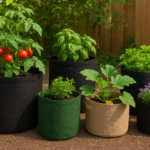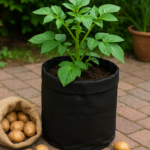Discover the captivating world of Philodendron Caramel Marble with our comprehensive guide. Learn about its origins, explore the ways of its cultivation, and gain valuable knowledge to care for this mesmerizing plant successfully.
Whether you’re a seasoned plant lover or a beginner, this detailed guide will equip you with the knowledge to nurture your Philodendron Caramel Marble and witnesses its stunning beauty thrive in your home.
Before we move on, let’s quickly go through some basic information that will set the stage for our exciting journey ahead.
| Common Name | Philodendron Caramel Marble |
| Scientific Name | Philodendron x serratum |
| Family | Araceae |
| Genus | Philodendron |
| Plant type | Hybrid |
| Native Habitat | South America |
| USDA Hardiness Zone | 9- 11 |
| Light | Bright indirect light |
| Soil | Well-draining and moist soil mix |
| Temperature | 65-80°F |
| Humidity | High |
| Water | Moderate |
| Fertilizer | Slow-release fertilizer |
| Pruning | Occasional |
| Repotting | Every two years |
| Toxic to Cats & Dogs | No |
| Toxic to Humans | No |
| Pests | Mealybugs, Aphids, Spider mites |
| Diseases | Root rot, Leaf Spot, Leaf Blight |
What Is Philodendron Caramel Marble?

Philodendron Caramel Marble is a unique and highly sought-after variety of the Philodendron plant.
It is characterized by its stunning foliage, which displays a captivating combination of caramel-colored patches and marbled patterns.
The leaves of the Philodendron Caramel Marble exhibit various shades of green, cream, and golden hues, creating a visually striking appearance.
The Philodendron Caramel Marble is a climbing plant that belongs to the Araceae family and is native to the tropical regions of Central and South America.
Its captivating foliage and relatively low maintenance requirements make it a popular choice among plant enthusiasts and collectors.
Origin
The Philodendron Caramel Marble is a relatively new cultivar, first appearing in the early 2000s. It is a cross between the Philodendron Caramel and the Philodendron Marble Queen. The Caramel Marble inherits its distinctive marbled foliage from the Marble Queen, while the Caramel adds a warm, caramel-colored hue to the leaves.
The Philodendron Caramel Marble is native to tropical regions of South America, including Brazil, Colombia, and Ecuador. It is a vining plant that can grow up to 10 feet long in its native habitat. However, when grown as a houseplant, the Philodendron Caramel Marble is typically much smaller, reaching a maximum height of 3-4 feet.
Unique Features Of Philodendron Caramel Marble Plant
The Philodendron Caramel Marble possesses several unique characteristics that set it apart from other plant varieties, making it a prized addition to any indoor plant collection. Here are some of its standout features:
Variegated Leaves

The variegated leaves of the Philo Caramel Marble are extremely eye-catching. They showcase a captivating combination of caramel-colored patches and marbled patterns, creating a visually stunning display. The intricate interplay of green, cream, and golden hues on the foliage adds depth and interest, making it a focal point in any space.
Climbing Nature
The Philodendron Caramel Marble is a climbing plant by nature, which means it possesses the ability to grow aerial roots and attach itself to supports such as moss poles or trellises.
This climbing habit allows for creative and versatile placement options, making it an excellent choice for vertical gardening or creating cascading displays.
Caramel Marble Growth Rate
While not overly fast-growing, the Philodendron Caramel Marble maintains a steady and moderate growth rate.
This makes it easier to control its size and maintain its shape within indoor spaces.
Regular pruning can help promote bushier growth and maintain the desired appearance.
Low-Maintenance
It thrives in bright, indirect light but can tolerate some shade.
It prefers well-draining soil and regular watering, allowing the top inch of soil to dry between waterings.
Additionally, providing moderate humidity and occasional fertilization can help ensure its health and vitality.
Air Purifying Qualities
Like other Philodendron varieties, the Caramel Marble is known for its air-purifying properties.
Its broad leaves have the ability to absorb and filter out common indoor pollutants, helping to improve air quality and create a healthier living environment.
Philodendron Caramel Size
The Philodendron caramel marble typically reaches up to about 3-4 feet in height.
Toxicity
Unlike the rest of the Philodendrons, this Philodendron is not toxic to humans and animals. Although it is recommended to keep this plant out of reach of pets as well as children to avoid any potential health complications.
Dormancy
Caramel marble enters into its dormant period if the temperature drops down below 50 degrees Fahrenheit. During its dormancy period, the leaves of the caramel marble plant start to turn yellow or brown. This variety will remain dormant until the temperature becomes favorable.
Philodendron Caramel Marble Care
Caring for a Philodendron Caramel Marble is relatively straightforward, and with proper attention, you can ensure its health and vitality. Here are some essential care guidelines to keep in mind:
Light Requirements
Place your Philodendron Caramel Marble in a location with bright, indirect light. While it can tolerate some shade, avoid exposing it to direct sunlight, as this can scorch the leaves. A north or east-facing window is generally ideal for this plant. Must keep your philo caramel in an area where it gets sufficient sunlight for at least 6 hours a day.
Temperature and Humidity
Philo Caramel Marble thrives in warm and humid conditions. Maintain a temperature range of 65-80°F (18-27°C) for your Philodendron Caramel Marble.
It prefers warm conditions, so avoid exposing it to cold drafts or temperatures below 60°F (15°C).
Sudden temperature fluctuations can stress the plant and lead to leaf damage. Aim for a stable and comfortable temperature within the recommended range to promote optimal growth.
Humidity
As a tropical plant, the Philodendron Caramel Marble appreciates higher humidity levels. Ideally, maintain humidity between 50% and 60%. During winter or in arid climates, try to increase humidity around the plant. You can increase humidity in a different way:
Humidifier: Using a humidifier is an effective and convenient method to maintain consistent humidity levels around the plant.
Pebble Tray: Fill a tray or saucer with water and place pebbles or stones in it. Set the potted Philodendron Caramel Marble on top of the pebbles, ensuring that the water doesn’t touch the pot’s bottom. It increases the humidity around the plant.
Misting: Regularly mist the leaves of the Philodendron Caramel Marble using a spray bottle filled with room-temperature water. This helps to mimic the natural humid conditions it thrives in.
Grouping: Grouping plants together can create a microclimate of increased humidity due to the collective transpiration of the plants. Place the Philodendron Caramel Marble near other houseplants to benefit from their combined humidity output.
Watering
Keep the soil evenly moist but avoid overwatering. Water your Philodendron Caramel Marble when the top inch of soil feels dry to the touch. Ensure proper drainage to prevent waterlogged roots, which can lead to root rot. Reduce watering during the winter months when the plant’s growth slows down.
Soil
Philodendron Caramel Marble thrives in a well-draining and moist soil mix that allows excess water to flow through. A suitable soil mixture of peat moss, perlite, and orchid bark is beneficial to this plant. This blend provides good aeration, water retention, and drainage. Alternatively, you can use a commercial potting mix formulated specifically for aroids or tropical plants.
Drainage: Essential for Healthy Roots
Proper drainage is essential for the healthier and bushier growth of your plant. Ensure that your chosen pot has drainage holes at the bottom to allow excess water to pass away. Placing a layer of pebbles or broken pottery shards at the bottom of the pot can enhance drainage by preventing the soil from blocking the drainage holes.
Fertilization Requirement
To ensure optimal growth, it is important to fertilize your Philodendron Caramel Marble every 14 days throughout its active growth phase. Make sure to provide a balanced fertilizer for instance 20-20-20 or 15-15-15. However, stop fertilizing when the plant enters its dormant stage.
Support and Training
As a climbing plant, the Philodendron Caramel Marble benefits from support like a moss pole or trellis. Guide the vines towards the support structure and secure them gently using soft ties or plant clips. This helps the plant climb and adds to its aesthetic appeal.
Repotting
It is a crucial task to ensure the continued growth and well-being of Philodendron Caramel Marble.
When your Philo plant spread out its current pot it is time to repot your plant.
- Choose a pot that is larger than the current one. This provides enough room for the roots to spread.
- Before repotting, carefully remove the plant from its current pot. Gently loosen the roots and inspect them for any signs of damage or diseases. Trim away any dead or decaying roots, if necessary.
- Place the Philodendron Caramel Marble in the center of the pot, ensuring that it sits at the same level as it did in the previous container. Fill the remaining space with additional potting mix.
- After repotting, water the plant thoroughly to settle the soil and provide hydration to the roots.
- Repot Philodendron Caramel Marble during the spring or early summer when the plant is in its active growth phase. This allows it to recover more quickly from the stress of repotting and take advantage of the favorable growing conditions.
- Regularly monitor the water and light requirements after repotting the plant.
You may also like
Pruning Caramel Marble Philodendron
Pruning is important to maintaining and shaping a Caramel marble plant. Regular pruning helps promote a bushier growth habit, control the plant’s size, and maintain its overall appearance.
Here are some guidelines to follow when pruning a Philodendron Marble plant:
Remove dead or damaged leaves
Start by removing any dead or yellowing leaves. Trim them off close to the stem using clean, sharp pruning shears or scissors.
Encourage bushier growth
To promote a fuller, bushier appearance, prune back the stems. Look for areas where the plant has become leggy or has long, bare stems. Make cuts just above a leaf node (the point where a leaf emerges from the stem). Cutting above a leaf node encourages new growth from that point, leading to a denser and more compact plant.
Control size
If the Caramel marble plant has outgrown its space or if you want to maintain a specific size, pruning can help. Trim back longer stems or branches to the desired length. However, avoid removing too much foliage at once, as it can stress the plant.
Shape and train
Pruning allows you to shape and train the Caramel Philo plant according to your preference. You can guide the plant’s growth by selectively removing certain stems or branches to create a desired form or direction.
Philodendron Caramel Marble Propagation
To expand your plant collection or share the beauty of these unique plants with others propagation is the easiest way.
There are a few methods you can use to propagate your Philo plant. All Philos, including Caramel Marble and Philodendron Ring Of Fire, can be propagated in a similar way, such as stem cutting and water propagation.
Stem Cutting Propagation
- Select a healthy stem from the parent plant that has at least two to three nodes (points where leaves emerge).
- Using clean and sharp pruners or scissors, make a clean cut just below a node leaving one or two leaves at the top.
- If desired, you can apply a rooting hormone to the cut end to promote root development (optional).
- Place the cutting in a container filled with a well-draining propagation mix, such as a combination of peat moss and perlite.
- Keep the soil consistently moist but not waterlogged and provide bright, indirect light.
- After a few weeks, you should start to see new roots forming.
- Once the roots are well-developed, you can transfer the cutting to a small pot with regular potting soil.
Water Propagation
- Select a healthy stem cutting, as described in the previous method.
- Fill a glass or jar with water and place the stem cutting in the water, ensuring that at least one or two nodes are submerged.
- Place the container in a location with bright, indirect light.
- Change the water every few days to prevent stagnation and the growth of harmful bacteria.
- Over time, you should see roots forming from the submerged nodes.
- Once the roots are well-established, you can transfer the cutting to a pot with well-draining soil.
Common Leaf Issues in Philodendron Caramel Marble
Philodendron Caramel Marble, like other plants, can sometimes experience leaf issues that may indicate underlying problems.
Here are some common leaf issues you may encounter with the Philodendron Caramel Marble and its potential causes:
Yellowing Leaves
It can occur due to various reasons, including overwatering, underwatering, nutrient deficiencies, or natural aging.
Assess the plant’s watering routine and adjust accordingly, ensuring the soil is neither too dry nor waterlogged. Consider fertilizing the plant with a balanced fertilizer to provide the necessary nutrients. If the yellowing is limited to older leaves at the bottom of the plant, it may be a natural process as new leaves emerge.
Brown Spots or Edges
Brown spots or edges on the leaves can be caused by inconsistent watering, underwatering, or low humidity.
Check the soil moisture regularly and water the plant when the top inch (2.5 centimeters) of soil becomes slightly dry. Increase humidity levels by misting the leaves or using a humidifier. Avoid using water with high salt content, as it can cause leaf burn.
Leaf Curling
Leaf curling can be a response to dry air, low humidity, or inadequate watering.
Increase humidity levels around the plant by misting the leaves or placing a tray of water nearby. Ensure the plant receives adequate watering, allowing the soil to dry slightly between waterings.
In some cases, curling leaves can also be caused by excessively high temperatures or direct sunlight, so adjust the plant’s placement accordingly.
Leaf Spotting or Discoloration
Leaf spots can occur due to fungal or bacterial infections.
Treat any visible pests with appropriate measures, such as insecticidal soap or natural predators.
For fungal or bacterial issues, consider using a fungicide or adjusting environmental conditions to discourage disease development.
Remove and dispose of severely affected leaves to prevent further spread. Assess the plant’s conditions and adjust as needed, providing stable and suitable growing conditions. Regularly inspecting your Philo plant leaves can help you identify and address any issues promptly.
Pests And Diseases of Philodendron Caramel Marble
Philodendron Caramel Marble is generally a resilient plant, but like any other houseplant, it can be susceptible to certain pests and diseases.
Here are some common pests and diseases that may affect the Philodendron Caramel plant.
Pests
1. Aphids: Aphids are small, soft-bodied insects that can gather new growth, causing curling and distortion. They can be found clustered on new growth, undersides of leaves, or along stems.
Use a strong stream of water to wash off aphids from the plant. Alternatively, you can apply insecticidal soap or neem oil following the product instructions. Repeat treatments may be necessary to fully eliminate the infestation.
2. Spider Mites: Spider mites are tiny pests that can cause webbing on the leaves and damage the plant by piercing the cells and sucking out the sap.
Regularly misting the leaves to increase humidity can help deter spider mites. If an infestation occurs, you can use insecticidal soap, neem oil, or horticultural oil following the product instructions. Ensure thorough coverage, targeting the undersides of leaves.
3. Mealybugs: Mealybugs are small, cotton-like insects that gather in clusters. They can be found on leaf joints, leaf undersides, and along stems. Infested areas may appear white or have a sticky residue.
Remove mealybugs manually using a cotton swab dipped in rubbing alcohol or soapy water. For severe infestations, you can use insecticidal soap or neem oil following the product instructions.
Diseases
Here is a common list of diseases that your Caramel Marble Plant can be afflicted with.
Leaf Spot
Leaf spot diseases are fungal or bacterial infections that cause spots or lesions on the leaves. The areas may vary in color, including brown, black, or yellow, and can sometimes have a concentric ring pattern.
Remove and destroy any infected leaves to prevent the spread of the disease. Ensure proper air circulation and avoid over-watering to minimize moisture on the foliage. Applying a fungicide or bactericide following the product instructions can help manage severe cases.
Root Rot
Root rot is caused by overwatering or poorly draining soil, leading to the decay of the plant’s roots. Symptoms include wilting, yellowing leaves, and a foul odor from the soil.
Address root rot by improving drainage conditions. Allow the soil to dry out slightly between waterings and ensure the pot has adequate drainage holes. Trim any affected roots and repot the plant using fresh, well-draining soil.
Leaf Blight
Leaf blight is a fungal disease that causes large brown or black spots on the leaves. Remove affected leaves and ensure proper air circulation and soil drainage. Apply a fungicide if the blight persists.
By staying vigilant and taking prompt action when necessary, you can effectively manage and mitigate pest and disease issues in your beloved Philodendron Caramel Marble, ensuring its health and vibrancy.
Philodendron Caramel Marble VS Ring of Fire
The Philodendron Caramel Marble and Ring of Fire are two distinct cultivars within the Philodendron genus. Here are the differences between them:
Foliage: The Philodendron Caramel Marble showcases heart-shaped leaves with a marbled pattern in shades of caramel, cream, and green. In contrast, the Ring of Fire exhibits elongated, lance-shaped leaves with a vibrant reddish-pink to orange coloration.
Growth Habit: Both varieties are climbers and can develop long aerial roots to help them climb and attach to support structures. They can be trained to grow on moss poles or trellises, adding elegance to any indoor space.
Availability: Availability may vary depending on location and nursery stock. The Philodendron Caramel Marble has gained popularity and is relatively more common in the market. The Ring of Fire, with its vibrant colors, is slightly more challenging to find and may require more effort to obtain.
Care Requirements: When it comes to care requirements, both plants share similar needs. They thrive in bright, indirect light, moderate to high humidity, and well-draining soil. Regular watering, balanced fertilization, and occasional pruning to maintain their shape are essential for both varieties.
While the Philodendron Caramel Marble and Ring of Fire are beautiful cultivars, they differ in terms of leaf shape, color intensity, growth rate, and availability.
Consider your preferences for foliage color and appearance when choosing between these two varieties.
Where to Buy Philodendron Caramel Marble
If you want to buy a Philodendron Caramel Marble, you can purchase it both online and offline. Here several options are available to you:
Local Plant Nurseries
Visit your local plant nurseries or garden centers. They may have Philodendron Caramel Marble in stock or be able to order it for you.
Online Plant Retailers
Explore online plant retailers that specialize in rare and exotic plants. Websites like Etsy, Amazon, eBay, and specialized plant shops often offer a variety of philodendron Caramel Marble plants for purchase.
FAQs
Why is Philodendron Caramel Marble so expensive?
Philodendron Caramel Marble is often more expensive due to its unique and highly sought-after foliage. The plant’s captivating marbled pattern and striking coloration make it a desirable addition to any plant collection, leading to higher demand and limited availability, which drives up the price.
How do you care for a Philodendron Caramel Marble plant?
To care for a Philodendron Caramel Marble, place it in bright, indirect light, and keep the soil consistently moist but not waterlogged. Maintain a moderate to high humidity level, and fertilize the plant during the growing season. Regularly check for pests and diseases, and trim any yellow or damaged leaves to promote healthy growth.
Where does Philodendron Caramel Marble come from?
Philodendron Caramel Marble is a cultivated variety of Philodendron, and its exact origin is not widely known. It is a hybrid or mutation of other Philodendron species..
What is the difference between Philodendron Caramel Marble and Pluto?
Philodendron Caramel Marble and Philodendron Pluto are different cultivars with distinct features. The Caramel Marble displays marbled caramel, cream, and green foliage, while Pluto exhibits dark green leaves with a reddish tint on the undersides. Both plants have their unique charm and can add visual interest to indoor spaces.
Is Caramel Marble variegated?
Yes, the Philodendron Caramel Marble is considered a variegated plant. Its variegation refers to the marbled leaf pattern, which features a mix of caramel, cream, and green colors.
Conclusion
Philodendron caramel marble is a stunning houseplant that adds elegance to any room. With variegated leaves, these Philodendron species are sought-after by aroid enthusiasts. They are low-maintenance, requiring warm temperatures to survive.







